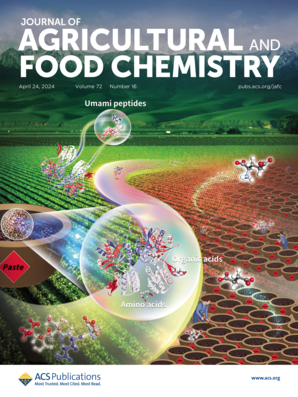Potassium Promotes Citric Acid Accumulation by Regulating Its Synthesis and Vacuole Storage in Newhall Navel Orange (Citrus sinensis)
IF 5.7
1区 农林科学
Q1 AGRICULTURE, MULTIDISCIPLINARY
引用次数: 0
Abstract
Potassium (K) is recognized as a crucial element affecting fruit flavor quality and influences the accumulation of citric acid (CA). To gain deeper insights into how K regulates CA accumulation, we investigated CA synthesis in mitochondria, decomposition pathways, and vacuolar storage under both pot and field culture in Newhall navel orange (Citrus sinensis). Our findings demonstrated that an appropriate level of K enhanced CA concentrations primarily by modulating CA synthesis, as evidenced by the increased activities and gene expressions of citrate synthase (CS) and phosphoenolpyruvate carboxylase (PEPC) in the early stages of fruit development. Integration of mitochondrial proteomic and targeted metabolomic revealed that K promoted CA synthesis by accelerating the TCA cycle, which were supported by the upregulation of TCA cycle-associated proteins, including malate dehydrogenase, 2-oxoglutarate dehydrogenase E2 component, pyruvate dehydrogenase E2 component, and dihydrolipoamide dehydrogenase, along with elevated levels of TCA cycle-related metabolites such as CA, isocitrate, 2-oxoglutarate, and succinate. Additionally, K enhanced CA concentration in vacuoles by promoting vacuolar acidification, as evidenced by the upregulation of P-type ATPase (CsPH8) expression. In summary, our findings provide novel insights into K facilitating CA accumulation by modulating its synthesis and vacuole storage in Citrus.

钾通过调控纽荷尔脐橙的合成和液泡储存促进柠檬酸积累
钾(K)是影响水果风味品质和影响柠檬酸积累的关键元素。为了更深入地了解钾是如何调控CA积累的,我们研究了纽霍尔脐橙(Citrus sinensis)在盆栽和田间培养下线粒体中CA的合成、分解途径和液泡储存。我们的研究结果表明,适当的钾水平主要通过调节CA的合成来提高CA浓度,这可以从果实发育早期柠檬酸合成酶(CS)和磷酸烯醇丙酮酸羧化酶(PEPC)的活性和基因表达的增加中得到证明。线粒体蛋白质组学和靶向代谢组学的整合显示,K通过加速TCA循环来促进CA合成,这得到了TCA循环相关蛋白(包括苹果酸脱氢酶、2-氧戊二酸脱氢酶E2组分、丙酮酸脱氢酶E2组分和二氢脂酰胺脱氢酶)的上调以及TCA循环相关代谢物(如CA、异柠檬酸、2-氧戊二酸和琥珀酸)水平升高的支持。此外,钾通过促进液泡酸化来增强液泡中的CA浓度,这可以通过上调p型atp酶(CsPH8)的表达来证明。总之,我们的研究结果为K通过调节柑橘中CA的合成和液泡储存促进CA积累提供了新的见解。
本文章由计算机程序翻译,如有差异,请以英文原文为准。
求助全文
约1分钟内获得全文
求助全文
来源期刊
CiteScore
9.90
自引率
8.20%
发文量
1375
审稿时长
2.3 months
期刊介绍:
The Journal of Agricultural and Food Chemistry publishes high-quality, cutting edge original research representing complete studies and research advances dealing with the chemistry and biochemistry of agriculture and food. The Journal also encourages papers with chemistry and/or biochemistry as a major component combined with biological/sensory/nutritional/toxicological evaluation related to agriculture and/or food.

 求助内容:
求助内容: 应助结果提醒方式:
应助结果提醒方式:


